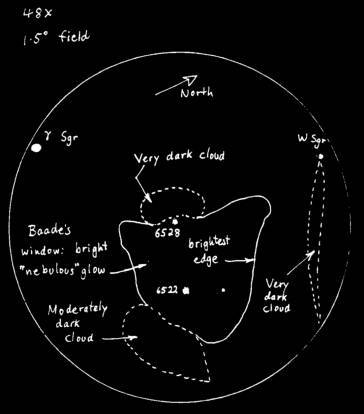BNGC 2. Contemplating The Galactic Navel
Back to Index of Beyond the NGC
By Steve Mencinsky, 1992
This month's object is quite off the beaten track in that it is an almost Rorsharchian object, not a "real" object, such as a galaxy or a globular cluster. Furthermore, unlike previous and planned future targets, which require a large telescope, this month's focus of attention is visible in binoculars. As if this is not enough, it can be plotted on THE most crowded page of Uranometria, map 377, yet it is not shown there!
First, locate the globular clusters NGC's 6522 and 6528. They are not particularly difficult - they are easily visible from Cremorne with the 12-inch. Sweep around the area with your binoculars or widest eyepiece. You'll need at least a degree and a half of field. Roll NGC 6522 around the field as if savouring a mouthful of a particularly fine red wine. From anything better than an indifferent sky, you should be able to see that this area is in a rich nebulous and starry haze with many dark and bright rifts and marblings.
What you are seeing is believed to be the part of the galaxy that is closest to the galactic core yet at the same time observable in the visible part of the spectrum. Apparently, a chance alignment of the dark galactic clouds that obscure the core has created a "hole" through which we poor galactic fringe dwellers can peer into the busy metropolitan downtown heart of our galaxy. This feature was observed at length and its nature divined by Walter Baade; it is therefore commonly known as "Baade's Window".
The diagram above / left shows the author's attempt to draw the bright and dark regions of Baade's window as observed with his aforementioned 12 inch Newtonian from Mt White, near Gosford. Naked eye limit at the time was about 6.0, with the seeing only fair. Since this is such a rich stellar area, this is only a line diagram, with no attempt to locate the myriad of background stars.
Baade's Window, NGC's 6533 and 6528. NGC 6522: (2000) 18h 02m -30a 02'


